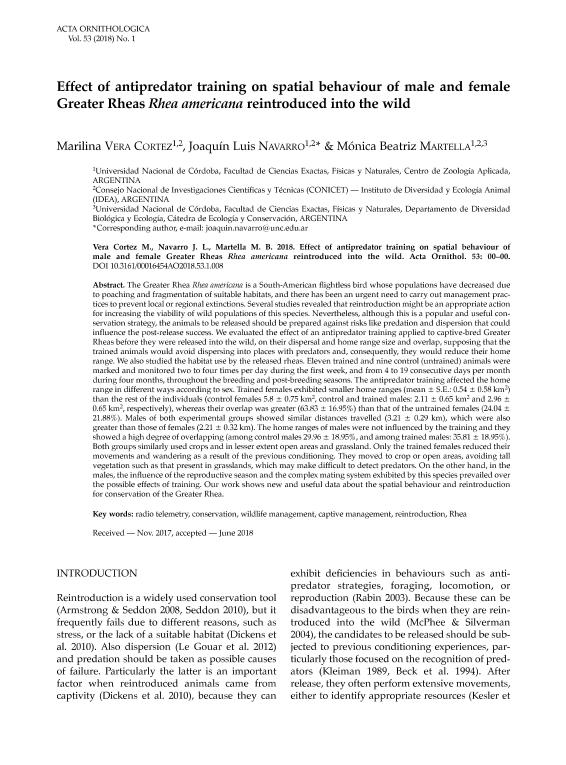Mostrar el registro sencillo del ítem
dc.contributor.author
Vera Cortez, Marilina

dc.contributor.author
Navarro, Joaquin Luis

dc.contributor.author
Martella, Monica Beatriz

dc.date.available
2019-11-27T14:00:37Z
dc.date.issued
2018-07-01
dc.identifier.citation
Vera Cortez, Marilina; Navarro, Joaquin Luis; Martella, Monica Beatriz; Effect of antipredator training on spatial behaviour of male and female Greater Rheas (Rhea americana) reintroduced into the wild; Museum & Inst Zoology; Acta Ornithologica; 53; 1; 1-7-2018; 81-90
dc.identifier.issn
0001-6454
dc.identifier.uri
http://hdl.handle.net/11336/90635
dc.description.abstract
The Greater Rhea (Rhea americana) is a South-American flightless bird whose populations have decreased due to poaching and fragmentation of suitable habitats, and there has been an urgent need to carry out management practices to prevent local or regional extinctions. Several studies revealed that reintroduction might be an appropriate action for increasing the viability of wild populations of this species. Nevertheless, although this is a popular and useful conservation strategy; the animals to be released should be prepared against risks like predation and dispersion that could influence the post-release success. We evaluated the effect of an antipredator training applied to captive-bred Greater Rheas before they were released into the wild, on their dispersal and home range size and overlap, supposing that the trained animals would avoid to dispersing into places with presence of predators and, consequently, they would reduce their home range. We also studied the habitat use by the released rheas. Eleven trained and nine control (untrained) animals were marked and monitored two to four times per day the first week, and from 4 to 19 consecutive days per month during four months, throughout breeding and post-breeding seasons. The locations of each animal were counted as a frequency of use of each of the five habitat types considered (crops, open areas, grassland, shrublands and salted flats) to compare these values between and within each group and sex. We estimated home range size and overlap, and the maximum linear distance travelled from the release site. The antipredator training affected the home range in different ways according to sex. Trained females exhibited smaller home ranges (mean ± S.E.: 0.54 ± 0.58 km2) than the rest of the individuals (control females 5.8 ± 0.75 km2, control and trained males: 2.11 ± 0.65 km2 and 2.96 ± 0.65 km2, respectively), whereas their overlap was greater (63.83% ± 16.95) than that of the untrained females (24.04, % ± 21.88). Males of both experimental groups showed similar distances travelled (3.21 ± 0.29 km), which were also greater than those of females (2.21 ± 0.32 km). The home ranges of males were not influenced by the training and they showed a high degree of overlapping (among control males 29.96% ± 18.95, and among trained males: 35.81% ± 18.95). Both groups similarly frequented the crops and in lesser extent open areas and grassland. Only the trained females reduced their movements and wandering as a result of the previous conditioning. They moved to crop or open areas, avoiding tall vegetation such as that present in grasslands that may difficult an earlier detection of predators. On the other hand, in the males, the influence of the reproductive season and the complex mating system exhibited by this species prevailed over the possible effects of training. Our work shows new and useful data about the spatial behaviour and reintroduction for conservation of the Greater Rhea.
dc.format
application/pdf
dc.language.iso
eng
dc.publisher
Museum & Inst Zoology

dc.rights
info:eu-repo/semantics/openAccess
dc.rights
Atribución-NoComercial-CompartirIgual 2.5 Argentina (CC BY-NC-SA 2.5 AR)
dc.rights.uri
https://creativecommons.org/licenses/by-nc-sa/2.5/ar/
dc.subject
CAPTIVE MANAGEMENT
dc.subject
CONSERVATION
dc.subject
RADIO TELEMETRY
dc.subject
REINTRODUCTION
dc.subject
RHEA
dc.subject
WILDLIFE MANAGEMENT
dc.subject.classification
Ecología

dc.subject.classification
Ciencias Biológicas

dc.subject.classification
CIENCIAS NATURALES Y EXACTAS

dc.title
Effect of antipredator training on spatial behaviour of male and female Greater Rheas (Rhea americana) reintroduced into the wild
dc.type
info:eu-repo/semantics/article
dc.type
info:ar-repo/semantics/artículo
dc.type
info:eu-repo/semantics/publishedVersion
dc.date.updated
2019-10-16T14:25:09Z
dc.journal.volume
53
dc.journal.number
1
dc.journal.pagination
81-90
dc.journal.pais
Polonia

dc.journal.ciudad
Warszawa
dc.description.fil
Fil: Vera Cortez, Marilina. Consejo Nacional de Investigaciones Científicas y Técnicas. Centro Científico Tecnológico Conicet - Córdoba. Instituto de Diversidad y Ecología Animal. Universidad Nacional de Córdoba. Facultad de Ciencias Exactas Físicas y Naturales. Instituto de Diversidad y Ecología Animal; Argentina
dc.description.fil
Fil: Navarro, Joaquin Luis. Consejo Nacional de Investigaciones Científicas y Técnicas. Centro Científico Tecnológico Conicet - Córdoba. Instituto de Diversidad y Ecología Animal. Universidad Nacional de Córdoba. Facultad de Ciencias Exactas Físicas y Naturales. Instituto de Diversidad y Ecología Animal; Argentina
dc.description.fil
Fil: Martella, Monica Beatriz. Consejo Nacional de Investigaciones Científicas y Técnicas. Centro Científico Tecnológico Conicet - Córdoba. Instituto de Diversidad y Ecología Animal. Universidad Nacional de Córdoba. Facultad de Ciencias Exactas Físicas y Naturales. Instituto de Diversidad y Ecología Animal; Argentina
dc.journal.title
Acta Ornithologica

dc.relation.alternativeid
info:eu-repo/semantics/altIdentifier/doi/http://dx.doi.org/10.3161/00016454AO2018.53.1.008
dc.relation.alternativeid
info:eu-repo/semantics/altIdentifier/url/https://bioone.org/journals/Acta-Ornithologica/volume-53/issue-1/00016454AO2018.53.1.008/Effect-of-Antipredator-Training-on-Spatial-Behaviour-of-Male-and/10.3161/00016454AO2018.53.1.008.short
Archivos asociados
